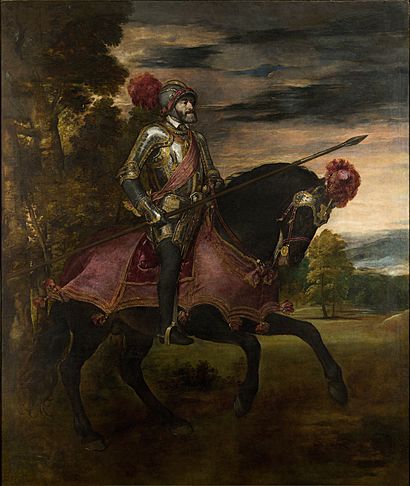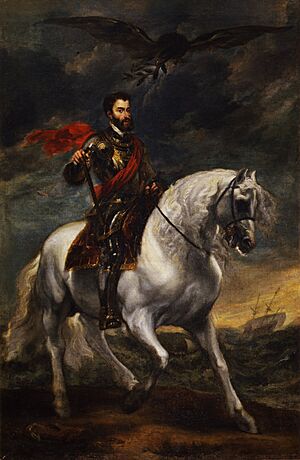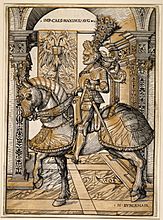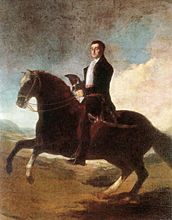Equestrian Portrait of Charles V facts for kids
Quick facts for kids Equestrian Portrait of Charles V |
|
|---|---|
 |
|
| Artist | Titian |
| Year | 1548 |
| Medium | Oil on canvas |
| Dimensions | 335 cm × 283 cm (132 in × 111 in) |
| Location | Museo del Prado, Madrid |
The Equestrian Portrait of Charles V is a famous painting by the Italian artist Titian. He painted it between April and September 1548. Titian was staying at the imperial court in Augsburg at the time.
This painting honors Charles V, Holy Roman Emperor. It was made after his big win in the Battle of Mühlberg in April 1547. In this battle, Charles V fought against Protestant armies.
The painting is powerful because it feels very direct. The horse looks strong, but also controlled. Charles V's shining armor and the deep red colors remind us of battle and bravery. The historian Hugh Trevor-Roper said that Charles V "does not exult in his victory." Instead, he looks calm, thoughtful, and peaceful.
Titian painted all the details in the foreground exactly as they were. This includes the horse, its special cover (called a caparison), and Charles V's armor. The real armor and horse harness still exist today. You can see them at the Royal Armoury in Madrid. The painting was part of the Spanish royal collection for a long time. It moved to the Museo del Prado in 1827.
Contents
Why Was This Painting Made?
This painting was asked for by Charles V's sister, Mary of Austria, Queen of Hungary. Charles V himself told Titian how he wanted to be shown. The emperor knew how important portraits were. They helped people see him as a strong ruler. He admired Titian's skill as a painter. He also liked how Titian presented him as a leader.
Titian's Friendship with Charles V
Titian painted another portrait of Charles V during the same visit. This one showed Charles V sitting down. The main version of this painting is now in Munich. Titian had already painted Charles V before this time. They knew each other well.
Titian was a very smart man. He was quick-witted, funny, and easy to be around. He became such good friends with Charles V that the emperor's helpers were worried. They thought a painter was getting too close to the emperor's secrets. While in Augsburg, Titian had an apartment near Charles V's. He could easily visit the emperor often.
During his time in Augsburg, Titian painted two portraits of Charles V. One was this equestrian (on horseback) portrait. The other was the seated civilian portrait. Titian called Augsburg "the glory of the world." He told his friend Lorenzo Lotto that he was getting many favors from the court and the Emperor.
What Does the Painting Show?

The painting mixes different art styles. Parts like the armor and horse harness look very realistic. This shows Titian's early painting style. But the trees, landscape, and sky are made with broad colors and strong brushstrokes. This is typical of his work from the 1540s onwards.
The painting has few symbolic elements, but they are there. Pietro Aretino, a writer Titian painted, suggested adding religious symbols. The lance (spear) reminds us of Saint George. He is a famous "military knight-saint." The red color on Charles' helmet, his sash, and the horse's trim stands for the Catholic faith. This was important during the wars of the 16th century. Titian wanted these reds to be very bright. He even asked for a special red pigment to be brought from Venice to Augsburg. He said this color was "so burning and so splendid." He thought it would make velvet and silk look less beautiful.
How Is the Horse Posed?
Titian was inspired by Roman art of soldiers on horseback. He also looked at Renaissance art, like engravings by Hans Burgkmair. He might have even been influenced by Dürer's 1513 engraving, Knight, Death and the Devil.
Titian changed the usual way of showing a rider on a horse. Usually, one of the horse's front legs is lifted. But in this painting, the horse is slightly rearing. Or it might be starting to gallop. Only its back legs are touching the ground. Charles V still holds the reins gently. He sits upright and looks relaxed. This shows he is a very skilled horseman.

The influence from Dürer's engraving is subtle. Dürer's knight rides through dark woods. He passes figures that represent evil and death. These include a devil and death on a pale horse. But Charles V rides out of a dark wood into an open landscape. This landscape looks a bit moody.
Charles V's Appearance
Titian shows a contrast between Charles V's age and his physical weakness. But he also shows him as a strong and determined leader. Titian paints Charles V heroically. Yet, he places him in a calm, early morning setting. There are no signs of battle.
Charles V's weakness is hinted at by the dark clouds above him. His face looks tired, and his lower jaw sticks out a bit. He also suffered from gout. In real life, he had to be carried to the battle in a litter. But in the painting, Titian makes him look steady and in control. He does this with the dark wood behind the rider and the evenly clouded sky. Charles V's gaze into the distance looks distant, but also firm. The way the spear is angled and the horse is charging suggests movement. It looks like Charles and his horse are arriving into the open landscape.
The sky also reflects Charles V's victory. But like the landscape, it has dark hints. The sky is considered Titian's best. It has been described as "flaming and shadowed." Golden light fights with blue, dark clouds. This landscape suggests the huge spaces Charles V ruled. It also shows the deep, inner feelings of his soul.
How Did This Painting Influence Others?
Many later equestrian portraits of kings and rulers were inspired by Titian's painting of Charles V. A clear example is Anthony van Dyck's 1620 Portrait of Charles I on Horseback. This painting uses many of Titian's ideas.
Francisco Goya's 1812 Equestrian Portrait of the 1st Duke of Wellington goes even further. It removes the sense of heroism. It shows a smaller, lonely figure. He looks tiny compared to his horse. He seems almost overwhelmed by the landscape around him. He is charging towards a dark sky.
Images for kids
-
Woodcut by Hans Burgkmair showing Maximilian I, Holy Roman Emperor (1508).
-
Equestrian Portrait of Charles I, by Anthony van Dyck, around 1637–38.
-
Equestrian Portrait of the 1st Duke of Wellington, by Francisco Goya, 1812.
-
The seated portrait painted in the same period, 1548, at the Alte Pinakothek, Munich.
See also
 In Spanish: Carlos V a caballo en Mühlberg para niños
In Spanish: Carlos V a caballo en Mühlberg para niños
- List of works by Titian





